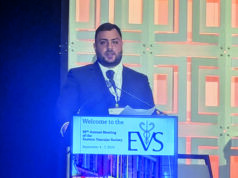
Patient-centered clinical success after lower-extremity revascularization for people with diabetic foot wounds was achieved among 63% of patients in a new analysis—but researchers suggest the measure on which the study was based may define clinical success too strictly given the high rates of limb salvage they saw among the high-risk population involved.
The data was revealed by Sarah Deery, MD, a fellow in the division of vascular surgery and endovascular therapy at The Johns Hopkins Hospital in Baltimore, during a session on peripheral arterial disease (PAD) at the Eastern Vascular Society virtual annual meeting (Oct. 7–Nov.18).
Deery et al set out to assess clinical success based on patient-centered outcome measures—described by Spence Taylor, MD, and colleagues in a 2007 paper published in the Journal of the American College of Surgeons—following lower-extremity bypass or peripheral vascular intervention for tissue loss in patients from her institution’s multidisciplinary diabetic limb preservation service.
First, Deery referenced the traditional markers of success following lower-extremity revascularization for chronic limb-threatening ischemia (CLTI) with ulcer or gangrene: amputation-free survival, limb salvage, and primary and secondary patency. “However, these may not fully capture success from a patient’s perspective,” she noted.
Taylor et al defined a new measure of clinical success after lower-extremity revascularization for tissue loss whereby a case was only considered a success if a patient maintains intervention patency to the point of wound healing, has limb preservation at one year, maintains ambulatory status for one year, and survives for at least six months.
“Among their population of 677 patients undergoing open and endovascular intervention for tissue loss, only 40% achieved clinical success by their definition,” Deery said. “Patency to the point of wound healing was the most discriminatory component, with 43.6% of intervention patency to the point of healing. This was driven more by low rates of wound healing at 44% than by intervention patency, which was 73% throughout the study period.”
Deery and colleagues accessed a prospectively maintained database for all patients who presented to the multidisciplinary diabetic limb preservation service at The Johns Hopkins Hospital, a source which tracks all wounds and surgical interventions as well as all hospital admissions since the service started in 2012.
The research team looked at all patients since inception who had a least one-year of follow-up, including only those with ulcer or gangrene and excluding those with rest pain or claudication. They analyzed 154 interventions, of which 70% were endovascular and 30% open repair. Two thirds of the group were male, with 59% Black and 35% white. All had diabetes—10% type I, 16% were on dialysis and 11% had had a kidney transplant.
While no significant differences were detected in terms of demographics and comorbidities, the investigators found that patients who underwent open bypass more often had gangrene, a prior vascular procedure, and were more likely to undergo an urgent intervention. Additionally, they also tended to be ranked as having a stage 4 wound on the wound, ischemia and foot infection (WIfI) classification system as well as multilevel peripheral vascular disease. “This is consistent with our practice pattern, which tends to offer endovascular intervention first,” Deery said.
“Our traditional markers of success at one year were quite high and consistent with our prior reports. One-year survival was 91%, amputation-free survival was 83%, and limb salvage 91%, with no differences in outcomes following endovascular or open intervention.
“When evaluating our patient-centered outcomes, intervention patency to wound healing was 72%, limb preservation was 90% at one year, 90% maintained their ambulatory status at one year, and survival at six months was 97%. This leads to an overall clinical success of 63%, which is higher than the 40% reported by Taylor and colleagues but is lower than any of the traditional markers of success. The number is driven down primarily by the lower rates of intervention patency to wound healing.”
Concluding, Deery said: “Despite these seemingly low values, 90% of patients had limb preservation at one year and had maintained their ambulatory status. So perhaps this particular measure of clinical success is too strict of a definition given the overall high rates of limb salvage seen in this high-risk population.”











